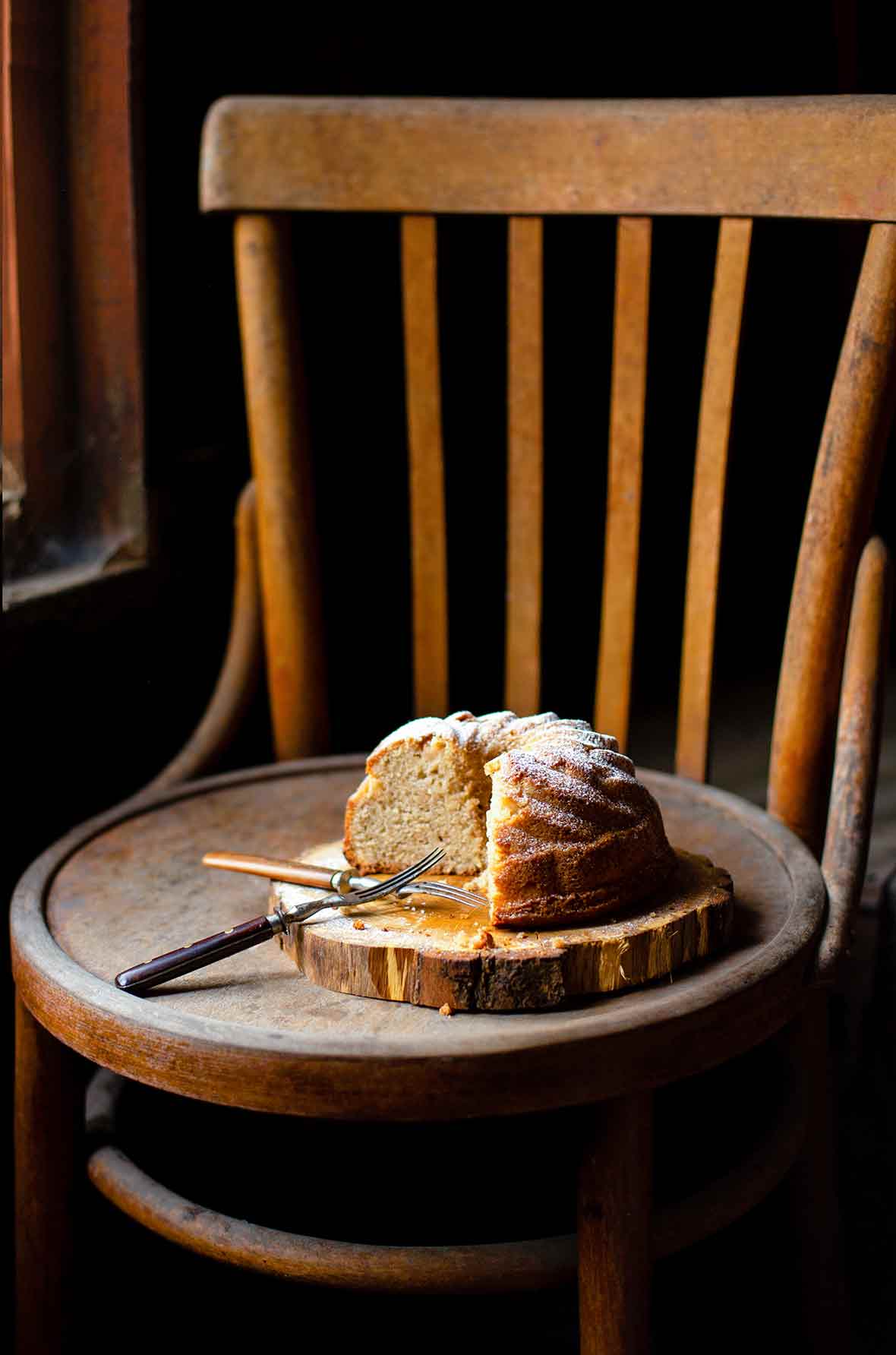
Saint Phanourios (pronounced “fan-OO-ree-os”) is to the Greek Orthodox what Saint Anthony is to the Catholics: the patron saint of lost things. But here’s the twist: this saint has a sweet tooth. Greeks bake, bless, and give away this humble nut-and-spice cake, also called a phanouropita, in return for the saint’s help to find something that’s missing. During my own year-long quest with the phanouropita, a friend’s grandmother showed me how to make the following version of this traditional Greek cake, which she likes to enjoy with morning coffee. Of the many recipes I’ve tried, it’s my favorite, because it’s so forgiving. The batter is easy to make by hand, and it’s all about proportions, which means you can use any reasonable measure (a coffee cup or drinking glass) in place of a standard cup. To my mind, the recipe’s looseness perfectly captures the spirit of Greek home cooking and offsets the formality suggested by Church and Saint. It also adheres to the traditional nine ingredients. (If you cheat just a little and count the cinnamon and cloves together as spices.) One unbreakable rule: Before you begin, take a moment to think of something you’d like Saint Phanourios to help you find—keep this in mind as you make the cake. If you’d like some divine company in the kitchen, print this image of the icon of Saint Phanourios and keep it within sight as you make the cake. Be warned, though—this alone won’t bring you what you seek. Sincerity is everything when conversing with a saint.–Allison Parker
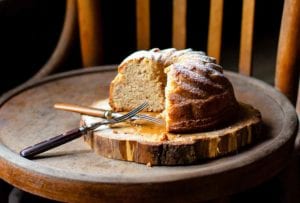
Saint Phanourios’s Cake
Ingredients
- 1 cup vegetable oil, plus more for greasing
- 1 cup fresh orange juice, (from about 3 oranges)
- 1/2 cup brandy
- 1 cup sugar
- 1 cup chopped walnuts
- 4 cups all-purpose flour, plus more for dusting
- 1 1/2 teaspoons baking soda
- 1 1/2 teaspoons baking powder
- 1 1/2 teaspoons ground cinnamon
- 1/4 teaspoon ground cloves
- Confectioners sugar, for dusting (optional)
Instructions
- Preheat the oven to 375°F (190°C) and adjust an oven rack to the middle position. Oil the bottom and sides of a 9-inch round cake pan or a Bundt or loaf pan of equal volume. Dust the pan with flour, tap out any excess, and set aside.
- In a large bowl, whisk together the oil, orange juice, brandy, and sugar until thoroughly combined. Mix in the chopped walnuts.
- In a medium bowl, combine the flour, baking soda, baking powder, cinnamon, and cloves. In small batches, add the flour mixture to the brandy mixture, whisking vigorously as you go. Continue whisking until completely combined. Tradition dictates that you're supposed to whisk for 9 minutes by hand.
- Scrape the batter into the prepared pan. Before putting the cake into the oven, pause to say whatever kind of prayer you feel comfortable with as you focus on the thing you hope to find. (Greek Orthodox women always make the sign of the cross, but the cake won't suffer if you skip this step.)
☞ TESTER TIP: The batter will be very thick and slightly gummy—not to worry. And if it seems impossibly thick, you can always splash in another tablespoon of brandy.
- Bake the cake until the top looks hard and golden brown and a toothpick inserted in the center comes out clean, about 40 minutes.
- Let the cake cool in the pan for 5 minutes and then remove the cake and let it cool completely on a wire rack.
- Traditionally, the cake is given away whole or cut into 9 pieces and shared with others. If you're serving the cake at home, you may want to sift a little confectioners' sugar over the top before slicing. The cake dries out easily, so if you do cut into it, make sure to wrap any leftovers well, first in plastic wrap and then in foil, or store in an airtight container.

An LC Original
View More Original RecipesNutrition
Nutrition information is automatically calculated, so should only be used as an approximation.
Recipe Testers’ Reviews
Hardly anything can go wrong while preparing this cake. The method is very simple, just mix the liquid and solid ingredients separately and then join them together. Although tradition says they should be mixed for 9 minutes, the magic number associated with the preparation of this cake dedicated to Saint Phanourios, my arm couldn’t take that long. But the result was very good: a soft cake with a strong flavor and a balanced sweetness.
Great accompaniment for a cup of coffee for breakfast!
Notes:
1. Makes one 23 cm cake.
2. Hands-on time: 25 min / Total time: 1 h 10 min
3. I used just the amount of brandy on the recipe
4. It took 40 minutes to bake
It may sound strange, but I did not hold out a lot of hope for this recipe. As a result I was very pleasantly surprised.
The recipe is easy to follow and doesn’t even require me to climb up and retrieve the mixer from the cabinet. (I’m short. Most rooms in my house contain at least one step stool.) I did take one liberty with the recipe; whisking the batter for 9 minutes was beyond my inclinations. By the time it was thoroughly mixed, I had been whisking for about 5 minutes, so I said an extra prayer and left it at that. To me, the batter wasn’t particularly either stiff or gummy, but at that point I may have tested the brandy a little more than I should have.
Baking was just under 40 minutes and the result was a cake that was perfect for having with my breakfast coffee the following morning. I made my version in a loaf pan and properly sliced it into 9 slices.
In case anyone is curious, my lost item has yet to appear. I tend to suspect my kleptomaniac cat had a hand (paw?) in its disappearance, in which case it will make a reappearance whenever I find his current stash. Plus I’m not sure how long to give the saint. 24 hours? 48 hours?
At least I got a nice coffee cake recipe out of the experience. And I lose a lot of things, so it may yet provide another bonus.
This cake fits into a comforting tradition of walnut cakes in Greek food, although I was not familiar with this particular Lenten version of cake, nor was I versed in the story of Saint Phanourios (Fanourios). I also liked the simplicity of hand mixing and having a bit to serve with coffee, a tradition of hospitality I love.
I made this cake using a neutral oil (avocado) but absolutely would try it with part or all olive oil the next time I make it, and perhaps a bit less flour to help it stay moist. Also, I would zest the oranges before squeezing for juice, and add them to the batter. The spicing is good but you could easily increase or double the cinnamon, and freshly ground clove is perfect at the amount suggested.
I think greasing the pan might work better with coconut oil (especially if using a Bundt pan with detail design), NOT melted, so no oil would pool at the ridges of the pan and collect too much flour. If you use vegetable oil, do it at the last moment so oil doesn’t start moving before you get the flour dusted.
All said, the flavor of the cake is lovely, simple, and, if wrapped tightly and stored in a closed container, will not change dramatically over several days. I gave away some and divided the remainder, putting some aside in the freezer for when we want a bit of not-too sweet cake to go with coffee or maybe a bit of Metaxa after dinner.
Use the best walnuts you can (I like the blondish Chandlers), make your own wish or prayer, and serve to those you love.
You can divide it into 9 slices, but in truth this serves 12 plus easily.
Even after 5 days (don’t judge me—cake is handy when the power is out) the cake is yummy. I will make it again for my mother, and add the orange zest, use olive oil, a touch less flour, and enjoy it again! Also, while I am at it, I might use Metaxa (which is a blend of brandy and grape juice) in place of the brandy. That will be a 10.
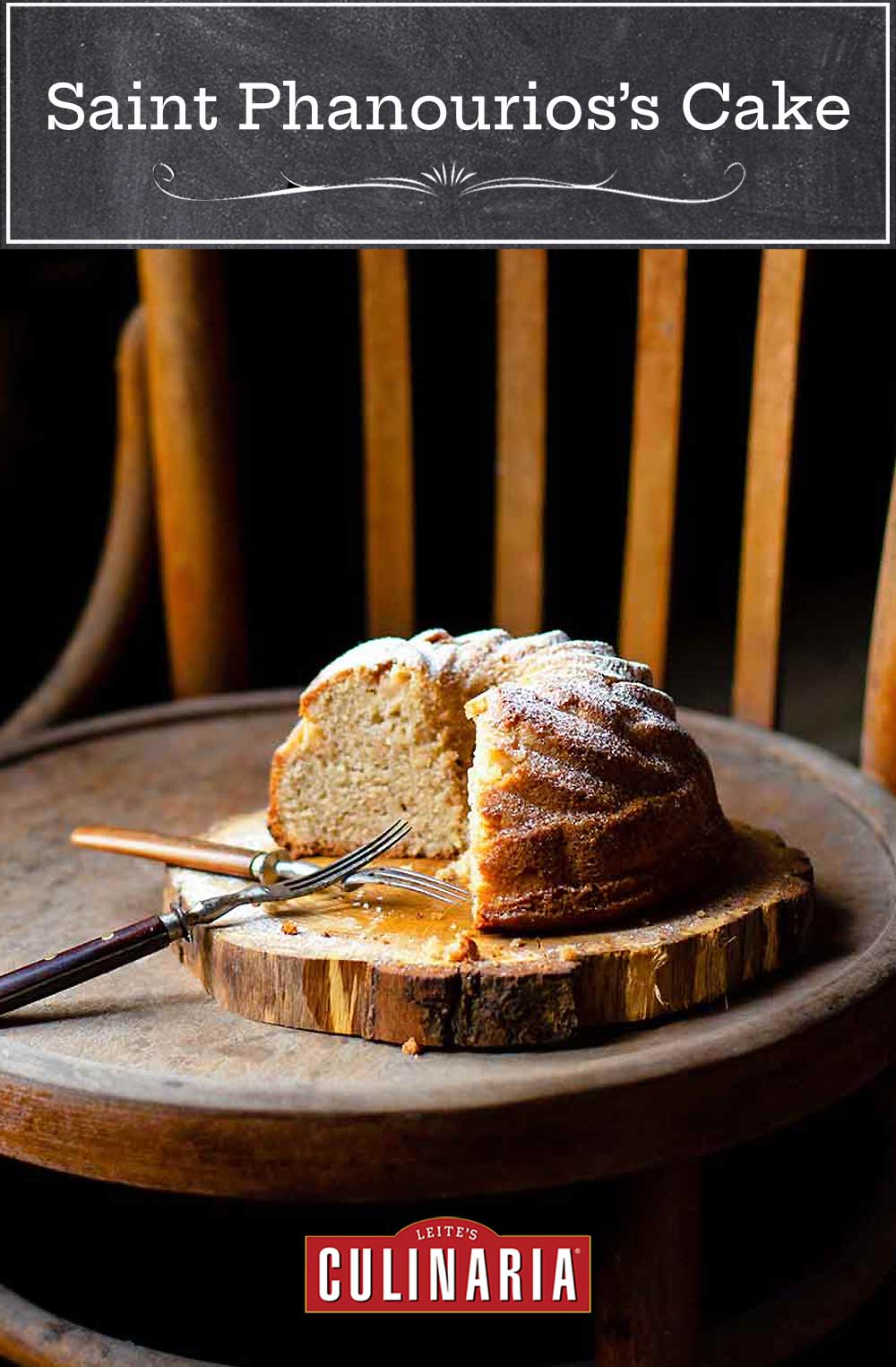



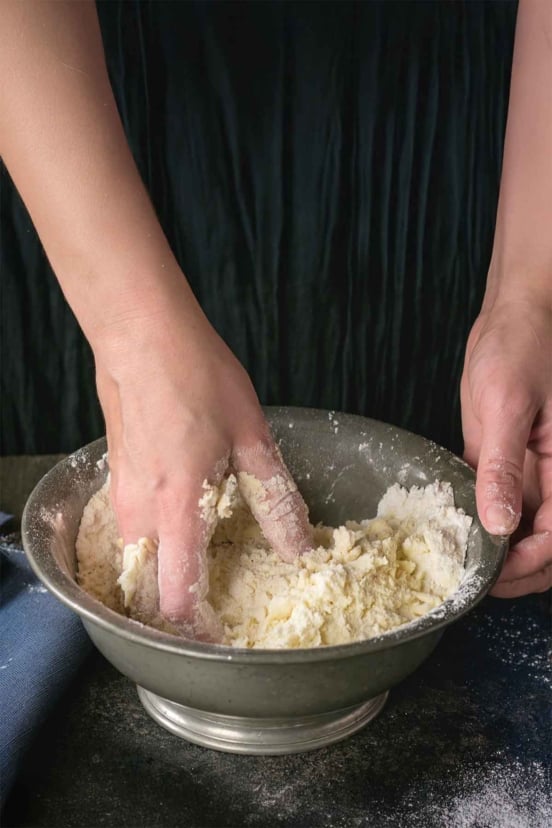
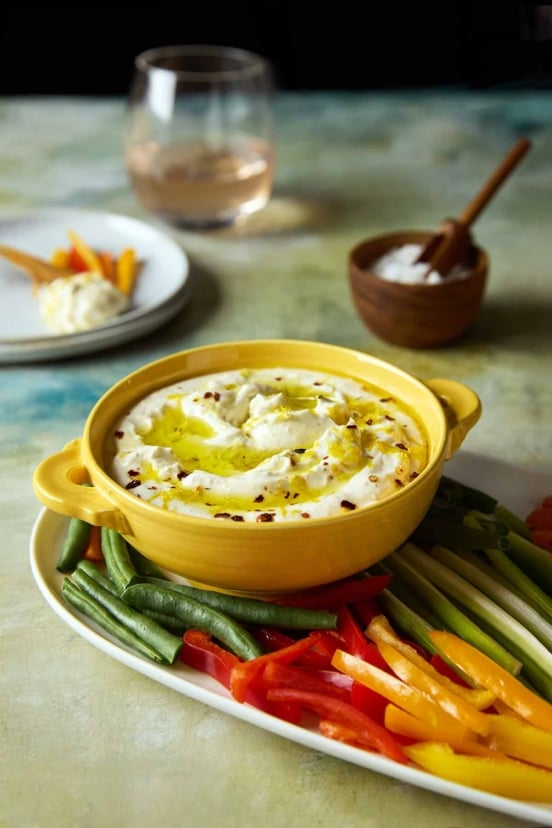









I love to bake, and baking a cake with magic behind it is irresistible. When you say that St. Phanourios will give you back something that you’ve lost, do you mean THINGS or even intangibles, like joy, desire, or motivation?
A few months ago, I lost a pouch containing my well-loved diamond earrings and a valuable watch. I looked all over the house but could not find it. Then, I heard that a saint—Saint Therese of Liseux—might help, so I prayed to her. They say that after your prayer to St. Therese, she will give you a sign of roses to confirm that she will help you. I got so many confirmations after my prayer, but the pouch still did not turn up. Finally, after 3 days, my husband called me from his office and told me that he found my pouch in his briefcase! To this day, we don’t know how my pouch ended up there but I’m not complaining. There is really something to this saint business.
Anyway, back to St. Phanourios, thank you Allison for your recipe and story. You have inspired me to bake a new cake and have introduced me to a new saint, to boot. I’ll let you know how the baking and the finding goes.
Cheers!
Thanks so much, Esther, for sharing your story—I’m so glad you found your jewelry! I didn’t know that Ste. Therèse was supposed to help in these matters.
As for Phanourios—I’ve heard of his finding salt cellars, husbands, jobs… but my own experience has proven to me that this process (the saint) works in mysterious ways and certainly, perhaps especially on behalf of someone looking for something intangible such as you describe.
I do hope that your baking and finding turn out as you wish. Let me know!
Thanks again for commenting.
Hi,
Loved your story. I can understand how isolated a freelancer stay-at-home mum can feel and am very glad you found your way out of this.
I love simple traditional cakes – i imagine all the Greek (and non-Greek) women who have been making this in their kitchens with ingredients at hand over the centuries. I’m Chinese but you can be sure i’ll attempt this some day and I already look forward to having this with some strong (greek?) coffee :))
Just a question: what is the texture like? moist i imagine as with oil-based cakes plus the orange juice. I’m just curious about the intensive mixing because most oil-based cakes call for stirring in gently. Is it just for tradition’s sake? not that i mind:) does it make the cake harder, stronger?
Thanks for the story and recipe!
Michaela,
Thanks so much for your comment. I also like to imagine all the hands over time that have made the same recipes I make. There’s something comforting about that. Also, simple cakes are lovely (and, yes, especially with some strong coffee—Greek or not).
As for your question…
The cake is moist enough when fresh, but the amount of flour and nuts keeps it from being spectacularly so. If you have in mind any oil-based cake that comes out like a pound cake—it’s not that texture. It’s a bit coarser, denser. As I mention in the recipe, the cake does dry out rather quickly so you have to be careful to wrap it well if you’re storing it for later.
The vigorous mixing is pretty much by necessity—the batter becomes very, very thick; to blend in the flour, you have to really put some muscle into your stirring, at least if you’re doing it by hand. Of course, in some other recipes for phanouropita, as I mention in the linked article, an element of tradition comes into play as well as far as the duration of mixing.
Thanks again for reading and commenting. I hope you’ll make the cake and tell me how you like it.
Hi, First off, thank you for replying to my other post and the wishes. I was wondering, can I substitute ground allspice for the ground cloves? That’s all I have. Also, given that the recipe is ‘flexible’, may I substitute the orange juice in my fridge for the freshly squeezed orange juice? Or will that alter the taste?
Thanks again!
You’re welcome!
To answer your questions, I think that yes, you could substitute allspice for the cloves to good effect. As for the orange juice . . . I really do believe that fresh juice is far superior to what you buy in the store, but in the interest of keeping things real around here, I confess that I have “cheated” with store-bought OJ in this recipe at least once. The cake still tasted good. I used juice without pulp (you can strain your juice if it has pulp in it). Just be sure that the juice is not old (or from concentrate) and it should be OK.
Good luck to you, and let me know how it turns out.
Hi,
I just cut the first slice, alas, the middle did cook properly. I swear I must have pricked the cake at least ten times, perhaps I didn’t prick the middle enough..
Sadly I can’t give these slices away..
However, I did try the crust and it was great! I love cinnamon, so I may add more next time..as well as cooking it longer.
Oh well, thanks again!
I’m so glad you tried the cake—and sorrier that it didn’t turn out for you. What type of pan did you use? If using a deep pan, then pricking the cake with a longer wooden skewer, right in the middle, might help you achieve a better “reading” on the cake’s doneness. I do hope you’ll give it another go sometime. As you were able to tell from the crust, the recipe does make a very tasty cake. If you do make another attempt, let me know how it turns out.
Hi again. I used a 9-inch round cake pan. I have a nagging feeling that my oven’s thermostat isn’t correct. I’m thinking of investing a thermometer. So I tried it again, this time I cooked for 50 min and inserted a skewer rather than a toothpick. It came out clean so I took it out, when I sliced into the middle still looked fairly dense. My slice tasted great, so I gave away the rest. My friend loved it!
Is this cake on the dense side? Also, I bit more spice and used 1/2 cup white sugar, 1/2 cup golden brown sugar. I love brown sugar in cakes and bread.
Thanks again!
Oh, I am so glad that you tried again. When you find a pan and bake time that work for you and your particular oven—stick with them. So glad that you liked the taste, shared it, and that your friend loved it, too. I’m also glad you experimented with the recipe. There’s tradition, and then there’s your own personal journey and connection to the cake. (And, yes, it is a more “dense” cake, as you notice—you’ll never get one that’s airy or fluffy; it’s just not that type of cake.) Thanks again for your persistence and letting us know about your great result! The saint should really pay attention to your dedication, I’d say.